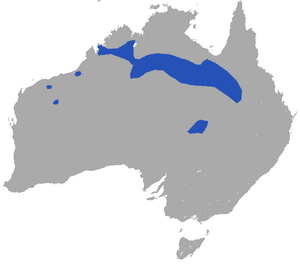Ingram's planigale facts for kids
Quick facts for kids Long-tailed planigale |
|
|---|---|
| Conservation status | |
| Scientific classification | |
| Genus: |
Planigale
|
| Species: |
ingrami
|
 |
|
| Long-tailed planigale range | |
The long-tailed planigale (Planigale ingrami) is a tiny marsupial from Australia. It's one of the smallest mammals in the world! You might not see it often, but it lives in the grassy plains and woodlands of northern Australia. It's also called Ingram's planigale or the northern planigale.
Contents
Naming the Long-tailed Planigale
Scientists give names to all living things to help us understand them. The long-tailed planigale was first named in 1906 by a scientist called Oldfield Thomas. He put it in a group called Phascogale.
Later, in 1928, another scientist named Ellis Le Geyt Troughton created a new group just for this animal and others like it. This new group was called Planigale. Since then, scientists have learned more about these tiny creatures.
Different Types of Long-tailed Planigales
Today, scientists recognize three main types, or subspecies, of the long-tailed planigale:
- P. i. ingrami: Found in the Northern Territory and up to Townsville, Queensland.
- P. i. brunnea: Lives around the Richmond area in Queensland.
- P. i. subtilissima: Found in the Ord Victoria Plain and the Kimberley region of Western Australia.
What Does a Long-tailed Planigale Look Like?
The long-tailed planigale has a very unusual head shape. All planigales have a flat head, but this one is super flat! Its skull is only about 3 to 4 millimeters (which is less than half an inch) from top to bottom. This means its head is five times wider than it is deep.
Why Such a Flat Head?
Scientists think this super flat head helps the planigale squeeze into tiny cracks in the soil. This is very useful in northern Australia. The clay soils there get deep cracks when they dry out after the rainy season. These cracks can be safe places to hide from predators or to find small insects to eat.
Other Features
Besides its flat head, the long-tailed planigale looks a bit like a very small mouse. It has a long, hairless tail and a pointy nose. Its fur is usually a plain brown color. Its back legs are a little bigger than its front legs. This lets it stand up on its hind legs and tail, like a tiny squirrel.
Size and Weight
From its head to the start of its tail, a long-tailed planigale is about 55 to 65 millimeters long (about 2 to 2.5 inches). Its tail is usually about the same length. On average, these tiny animals weigh around 4 grams, which is less than a teaspoon of sugar! Some bigger ones can weigh almost 6 grams.
What Do Long-tailed Planigales Eat?
Like all animals in its group (called Dasyuromorphia), the long-tailed planigale is a carnivore. This means it eats other animals. It hunts mostly at night, looking for food in leaf litter and inside soil cracks.
Hunting Habits
It's a very active and brave hunter, even though it's so small. It mainly eats insects and their young (called larvae). It also preys on small lizards and even young mammals that are almost as big as itself!
When it catches larger prey, like a grasshopper, it might pounce on it first. Then, it bites the prey many times until it stops moving. Usually, the planigale only eats the soft parts of its prey, leaving behind hard bits like heads or wings.
Reproduction and Life Cycle
Long-tailed planigales can have babies at any time of the year. However, they usually breed more often during the wet season in Australia.
A mother planigale typically gives birth to four to eight young. Sometimes, in southern areas, she might have as many as 12 babies! The tiny babies spend about six weeks inside their mother's pouch. The pouch faces backward.
After leaving the pouch, the young planigales stay hidden for another six weeks. They usually hide in a grassy nest under bark or other plants. While they are hidden, their mother goes out each night to find food for them.
Where Do Long-tailed Planigales Live?
The long-tailed planigale likes to live in floodplains and woodlands where the soil is cracked clay. They also live near rivers and in blacksoil plains.
You can find them across northern Australia. Their home stretches from the Pilbara region in Western Australia, through the Great Sandy Desert and the Kimberley region, to the Barkly Tableland in the Northern Territory, and all the way to Townsville in Queensland.
See also
 In Spanish: Planigale ingrami para niños
In Spanish: Planigale ingrami para niños


